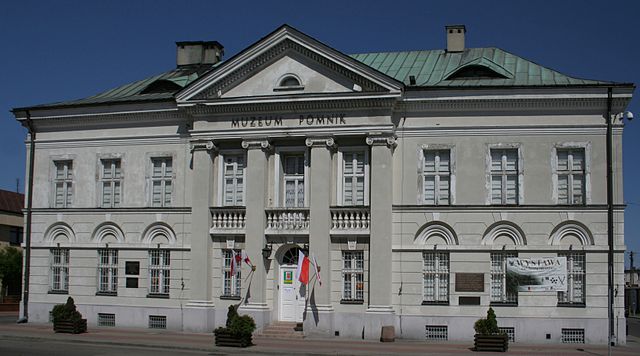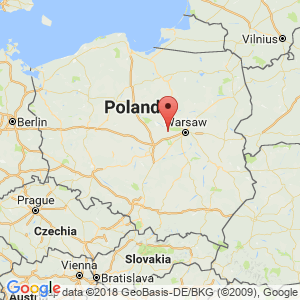Sochaczew

Regional Museum in Sochaczew, housed in the town hall building. – Photo by: Przykuta, Sochaczew muzeum 01.05.09 p, CC BY-SA 4.0
Distance
Population
37.374 (2011)
Location and history
Sochaczew is located in central Poland, west of the capital Warsaw, by the river Bzura and its tributary Utrata.
The first mention of Sochaczew takes place in a manuscript from the 14th century, which mentions that Prince Bolesław III Krzywousty died in 1138 in the Benedictine monastery here. Another old source is from 1221 and deals with the Mayor (Castellan) Falanta. Sochaczew was then the center of a castle, the center of local administration of that time. The castle resided in a bourgeois settlement fortified with wooden palisades and earthquakes. It is believed that this fortress stood on the high, where in the middle of the 14th century. was built an actual castle.
The city of Sochaczew grew quite rapidly, as evidenced by the construction of two churches: the parish church of St. Wawrzyniec and the Dominican church of St. Mikołaj. Both churches were consecrated by the bishop of Płock in 1257.
The town gained market town rights in the 14th century, of course before 1368. Prince Siemowit III organized a meeting in Sochaczew with the participation of the Masovian princes.
In 1476, Sochaczew was incorporated by King Kazimierz Jagiellończyk into the Kingdom of Poland (also called “The crown”). At this time there were quite a few specialized craftsmen in the city, a total of 22 trade groups, including butchers, dressmakers, blacksmiths, blacksmiths, gunsmiths, gunsmiths, archers.
In 1570, there were three foundation-walled buildings in the city: 2 churches and 1 residential building. But believe that the city at that time had 3,000 inhabitants. Sochaczew was protected by a wood palisade around the city.
In 1618 and 1644 the city was partially destroyed by fires. In 1655 Sochaczew was taken by the Swedes.
At the second division of Poland in 1793, Sochaczew came under Prussian rule. In this connection, the Prussians conducted a census, business and housing census in the city. At that time, 1152 people lived in the city, including 997 Jews. In 1807, the city was part of the Principality of Warsaw. From 1815 Sochaczew was under Russian rule.
In 1828, there were 3237 inhabitants, of whom 76% were Jews. During the January uprising of 1863-64 (the uprising against the Russians), several meetings took place near Sochaczew between the rebels and Russian forces. By 1888 the population had risen to 6794 (of which 78% were Jews). From 1903, the city connected with Warsaw through the construction of the Warsaw-Łódź-Kalisz railway.
During World War I, the city was destroyed by German troops. After the war – in the rebirth of Poland – a comprehensive and long-lasting reconstruction began. In 1928, the People’s University of Agriculture was founded in Sochaczew.
In the first days of September 1939, the Germans bombed Sochaczew. Few days after commenced “Battle of Bzura” between German troops and Polish defense forces. After German victory, the Nazi forces occupied the city, which had already been substantially destroyed. From the beginning, the Germans waged terror against both the Jewish and Polish inhabitants. As of September 1944, 75,000 people displaced from the destroyed Warsaw were living in Sochaczew, making living conditions even more difficult. In January 1945, the city was liberated by the Soviet army. During the war, 40% of the buildings in the city were destroyed and approx. 4,000 inhabitants perished.
In 1999, Sochaczew again became the main city of Sochaczew district.
Tourist attractions
Selected attractions:
The ruins of the castle of the Masovian princes
The castle is believed to have been built in the middle of the 14th century. From the remaining ruins, it can be calculated that the castle was originally built on a trapezoid-like floor plan. The castle’s dimensions were 35 × 30 meters and covered approx. 1200 m2. The building material was brick made of brick, while the foundation consisted of field stone. However, inside the defensive wall, the buildings of the castle were initially built of wood. There were two towers: the east and the north, both on the outside of the ring wall. It is believed that access to the castle was initially through the wall at the northern tower but has since been moved to the eastern tower, where remains of an oak bridge with handrails have been found. The ring wall was 2.5 m thick, but the height is unknown. There was a moat around the castle. Unfortunately, there was no well in the castle area. The required water was produced via an aqueduct.
The castle was destroyed by the Swedes in 1555 but later rebuilt. The plant was finally destroyed by the Prussians in 1794.
City Hall building
is the seat of the Museum of the Sochaczew region and the Battlefield of the Battle of Bzura.
Kramnice miejskie
Classic building from 1828-33, which serves as a market hall.
Surrounding Area
Museums:
Azelazowa Wola
Chopin Museum. In the village of azelazowa Wola immediately northeast of Sochaczew lies the house where the Polish composer Frederic (Fryderyk) Chopin (1810-1849) was born. It is a museum for the artist – as part of the Fryderyk Chopin Museum in Warsaw. – Take a closer look Azelazowa Wola and the Chopin Museum here Warsaw – page 7.
Lakes:
Boryszew Lake (artificial lake), located southwest of the city.
rivers:
Bzura which flows from the south to the north at Sochaczew and later flows into Wisła.
Several tributaries to Bzura, of which Pisia in the southern part of the city.
forests:
To the northeast: Puszcza Kampinoska Natural Forest, designated as a national park: Kampinoski Park Narodowy .
To the south: Landscape Park Bolimowski Park Krajobrazowy .
Accommodation
Sochaczew (in Polish, English, German, French, Russian, Ukrainian) – with practical information for tourists
Eating Out:
Sochaczew (in Polish, English, German, French, Russian, Ukrainian) – with practical information for tourists
Other Internet sites and sources
Sochaczew (in Polish, English, German, French, Russian, Ukrainian)
Translated into English by Google Translate. Spangshus.dk accept no liability for any errors or omissions in translation.
Map

Rating
Search
Most used tags
churches (205) Castles (86) Monasteries (79) Town walls (74) Lakes (71) Town halls (67) Rivers (65) Castles1 (62) Mansions (55) Museums (51) Regional museums (38) Town gates (36) Abbey churches (35) Castle ruins (30) Cathedrals (26) Forests (25) Health resorts (24) Mounds (23) Water sports (23) National parks (22)Click for all tags
Denne side er også tilgængelig på dansk. This page and contents is (c) Copyright 2018- www.spangshus.dk. Based on Inviator software by ISCA Software